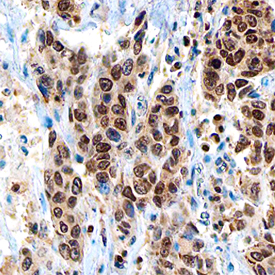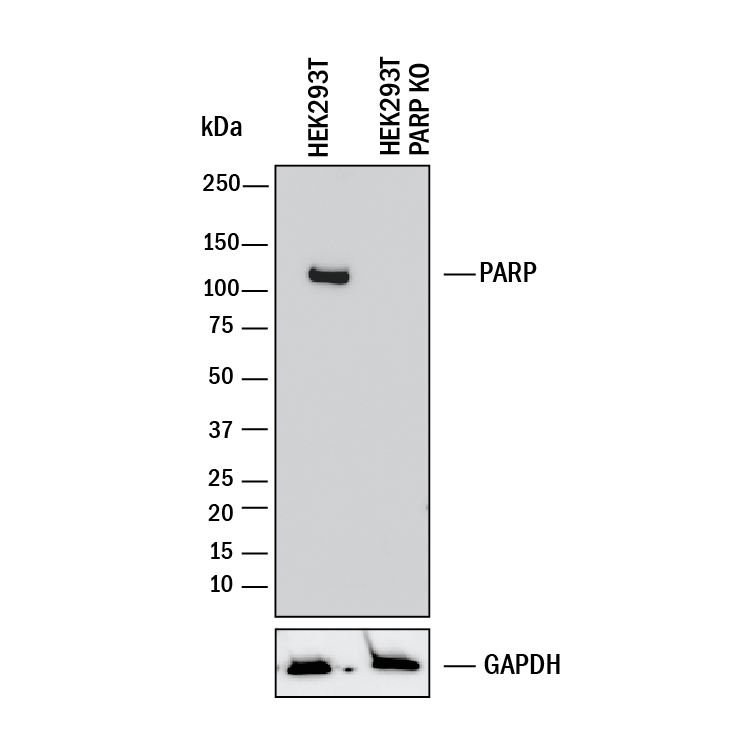Human PARP Antibody Summary
Thr373-Glu540
Accession # P09874
Applications
Please Note: Optimal dilutions should be determined by each laboratory for each application. General Protocols are available in the Technical Information section on our website.
Scientific Data
 View Larger
View Larger
Detection of Human PARP by Western Blot. Western blot shows lysates of HeLa human cervical epithelial carcinoma cell line. PVDF membrane was probed with 1 µg/mL of Mouse Anti-Human PARP Monoclonal Antibody (Catalog # MAB8095) followed by HRP-conjugated Anti-Mouse IgG Secondary Antibody (Catalog # HAF018). A specific band was detected for PARP at approximately 110 kDa (as indicated). This experiment was conducted under reducing conditions and using Immunoblot Buffer Group 1.
 View Larger
View Larger
PARP in Human Breast. PARP was detected in immersion fixed paraffin-embedded sections of human breast using Mouse Anti-Human PARP Monoclonal Antibody (Catalog # MAB8095) at 15 µg/mL overnight at 4 °C. Before incubation with the primary antibody, tissue was subjected to heat-induced epitope retrieval using Antigen Retrieval Reagent-Basic (Catalog # CTS013). Tissue was stained using the Anti-Mouse HRP-DAB Cell & Tissue Staining Kit (brown; Catalog # CTS002) and counterstained with hematoxylin (blue). Specific staining was localized to the nuclei of epithelial cells. View our protocol for Chromogenic IHC Staining of Paraffin-embedded Tissue Sections.
 View Larger
View Larger
Detection of Human PARP by Simple WesternTM. Simple Western lane view shows lysates of Jurkat human acute T cell leukemia cell line and HeLa human cervical epithelial carcinoma cell line, loaded at 0.5 mg/mL. A specific band was detected for PARP at approximately 125 kDa (as indicated) using 10 µg/mL of Mouse Anti-Human PARP Monoclonal Antibody (Catalog # MAB8095). This experiment was conducted under reducing conditions and using the 12-230 kDa separation system.
 View Larger
View Larger
Western Blot Shows Human PARP Specificity by Using Knockout Cell Line. Western blot shows lysates of HEK293T human embryonic kidney parental cell line and PARP knockout HEK293T cell line (KO). PVDF membrane was probed with 1 µg/mL of Mouse Anti-Human PARP Monoclonal Antibody (Catalog # MAB8095) followed by HRP-conjugated Anti-Mouse IgG Secondary Antibody (Catalog # HAF018). A specific band was detected for PARP at approximately 120 kDa (as indicated) in the parental HEK293T cell line, but is not detectable in knockout HEK293T cell line. GAPDH (Catalog # MAB5718) is shown as a loading control. This experiment was conducted under reducing conditions and using Immunoblot Buffer Group 1.
Reconstitution Calculator
Preparation and Storage
- 12 months from date of receipt, -20 to -70 °C as supplied.
- 1 month, 2 to 8 °C under sterile conditions after reconstitution.
- 6 months, -20 to -70 °C under sterile conditions after reconstitution.
Background: PARP
PARP, Poly [ADP-ribose] polymerase 1 (PARP1), is a widely expressed component of a base excision repair (BER) complex, containing at least XRCC1, PARP2, POLB and LRIG3. PARP expression is correlated with proliferation, with higher levels occurring during early fetal development and organogenesis and in the highly proliferative cell compartments of adult. PARP is upregulated in B cells that have been induced to switch to various Ig isotypes. PARP interacts with the DNA polymerase alpha catalytic subunit POLA1; this interaction functions as part of the control of replication fork progression.
Product Datasheets
Citation for Human PARP Antibody
R&D Systems personnel manually curate a database that contains references using R&D Systems products. The data collected includes not only links to publications in PubMed, but also provides information about sample types, species, and experimental conditions.
1 Citation: Showing 1 - 1
-
RAP80 and BRCA1 PARsylation protect chromosome integrity by preventing retention of BRCA1-B/C complexes in DNA repair foci
Authors: J Vohhodina, KJ Toomire, SA Petit, G Micevic, G Kumari, VV Botchkarev, Z Li, DM Livingston, Y Hu
Proc. Natl. Acad. Sci. U.S.A., 2020-01-13;117(4):2084-2091.
Species: Human
Sample Types: Cell Lysates
Applications: Western Blot
FAQs
No product specific FAQs exist for this product, however you may
View all Antibody FAQsReviews for Human PARP Antibody
Average Rating: 5 (Based on 1 Review)
Have you used Human PARP Antibody?
Submit a review and receive an Amazon gift card.
$25/€18/£15/$25CAN/¥75 Yuan/¥2500 Yen for a review with an image
$10/€7/£6/$10 CAD/¥70 Yuan/¥1110 Yen for a review without an image
Filter by:


